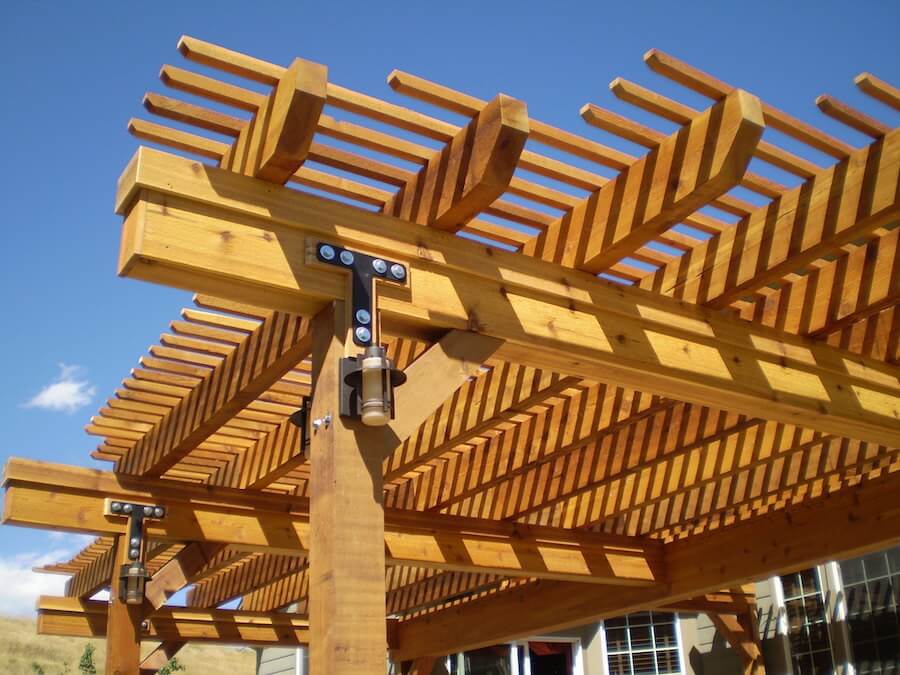Wood is the most prevalent material for pergola constructions. It possesses a vintage beauty and a premium natural texture that no other material can match.
However, natural wood is very expensive, and it will slowly rot over many years.
Nowadays, pressure-treated wood has risen as a new star thanks to its high durability and many superior characteristics.
So, should I use pressure-treated wood for a pergola? If you are asking this question, you have come to the right place!
I will discuss the advantages and limitations of pressure-treated wood to give you a straightforward answer. Scroll down to see more right now!
Table of Contents
Should I Use Pressure Treated Wood For A Pergola?
The answer is yes. You can use pressure-treated wood for building pergolas as a budget-friendly option.
With high durability and immunity to environmental factors, this material is a good and affordable choice for pergolas.
Natural wooden materials found in nature come at very high costs, and they are less accessible. Due to their hard and natural texture, you cannot customize their shape and size very effectively.
Meanwhile, pressure-treated wood can counter most of these issues thanks to its high availability and affordable prices. Pressure-treated wood, or PT wood, is very malleable and produced by many facilities around the globe.
What Makes Pressure Treated Wood A Material For A Pergola?
After getting pressure-treated, the wood surface becomes more resistant to environmental impacts like moisture, fire, decay, rot, and insects. This high immune capacity is vital for any pergola or gazebo construction.
Since your pergola is exposed to moisture, rain, and sunlight throughout the year, it will slowly rot and lose its initial beautiful appearance. Pressure-treated wood can eliminate this problem and prolong the beauty of your pergola.
Another edge of pressure-treated wood lies in its affordable price and malleability. On the market, you can find many high-quality PT wood at much lower price ranges than natural woods or bricks used for building pergolas.
In addition, its malleability also makes PT wood a favorite choice for pergola builders. PT woods are easy to cut, shape, and work with, allowing owners to customize their pergola and achieve their desired design.
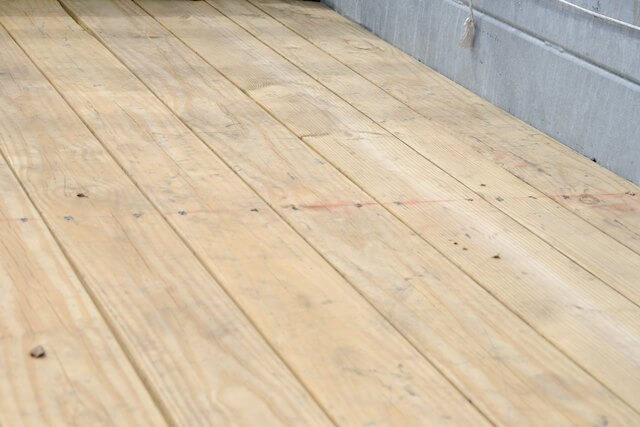
When Should You Not Use Pressure-Treated Wood For A Pergola?
Despite many superior features, pressure-treated wood comes with some significant setbacks that you should consider carefully. The first limitation comes from the chemical components used for making PT wood.
These chemical components are not toxic in a newly produced PT wood deck, but they will become poisonous when you’re exposed to the deck’s ash or smoke. Some CCA-treated wood also possesses a chemical substance called arsenic.
Arsenic will increase your risk of lung and skin cancers, along with many serious health threats. In addition, PT wood pergola is not the best choice for your pets since they like to scratch the pergola’s surface.
PT woods don’t deliver the aesthetic and premium look of natural, high-quality wood. They have a blue streaking or small tint on the surface, which many homeowners may find unattractive.
Restaining or sealing the wood to get your favorite color will add more cost to the construction and hurt your budget.
Summing Up
Suppose you are looking for a budget-friendly and decent-looking material for your pergola. In that case, pressure-treated wood is a perfect choice. Though it doesn’t have a premium look, its high durability is indisputable.
In addition, PT wood is malleable and easy to find, helping you save tremendous effort in the planning and building process.
However, there are better choices than PT wood for homeowners valuing a premium and natural look for pergolas.
If you have a large house made of natural wood, a PT wood pergola won’t be the best match for your backyard. But how about its poisonous chemical properties? PT wood is generally safe for humans and pets to contact.
You need to follow safety precautions and avoid scratching or burning PT wood surfaces because its ash is poisonous. I recommend you choose high-quality PT woods that have been certified safe for human health.
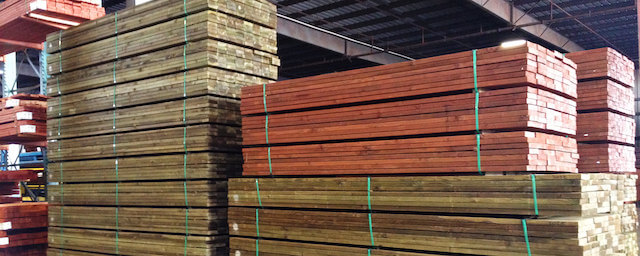
The Other Wood types for Pergolas and Gazebos
So that’s everything you need to know about the advantages and limitations of PT wood. If you decide that PT wood is not the best match, here are some recommended substitutions to consider.
Western Red Cedar and Redwood
Besides PT wood, redwood and western red cedar are common for pergola constructions. They are all-natural and have a stunning look that no other material can resemble.
There’s a slight difference in their texture and appearance, as Western red cedar features a mild yellow color. Meanwhile, redwood looks darker with a red-brown color.
These two materials are natural, yet they can resist rot and insects very well.
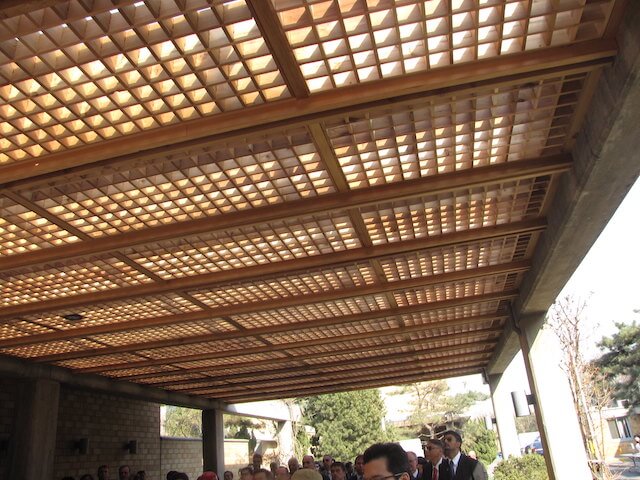
Tropical Hardwood
Tropical hardwood is very challenging to handle and is only favored by adept woodworkers when building a pergola.
Some common hardwoods in tropical regions are mahogany, rosewood, or ipe.
Besides their stunning beauty, hardwoods possess excellent durability and resilience to environmental factors. In general, wood is rated based on its hardness, and hardwood is at the top of the tier.
Modified Wood
Modified wood is an ideal choice for customers looking for a balance between beauty, price, and durability. Its texture density and hardness are no less inferior to tropical hardwood.
In addition, modified wood doesn’t require much effort and treatment to preserve its beauty. It can last for many years under extreme weather conditions like high moisture and heavy rainfall.
How To Choose The Best Wood for Pergola Designs Based On Location
Always consider the climate conditions in your location when selecting a wood material for pergolas. Does it have extreme weather conditions like acid air, harsh sunlight, or heavy year-round rainfall?
The pressure-treated pine wood is ideal for coastal areas with high humidity and year-round rainfall. Natural wood is very durable, but it will slowly rot when contacting the acid rain and wind from the ocean.
If you use natural wood, ensure to apply proper sealant and maintenance for your pergola. You can contact the local pergola and material store for advice on taking care of the pergola texture.
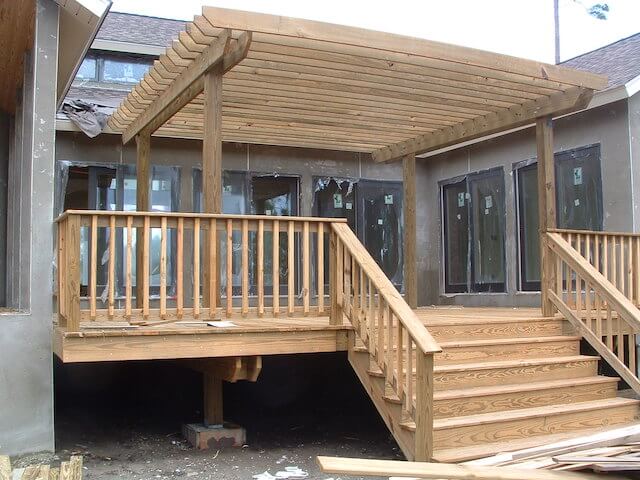
Sealing Or Staining Right Away? Wood Type Matters!
Before getting pressured-treated, the wood has an initial green color and then turns yellow. Therefore, I recommend you stain or seal the pergola after it has been constructed.
This practice is advisable for pressure-treated pine wood. However, you can seal and stain the material right away when using pressure-treated cedar.
Tips for Staining And Sealing Cedar Or Pine Pergolas
If you use one of these two PT wood types, ensure to choose a high-quality stain with a reliable warranty policy from reputable providers. Some additional requirements are the stain’s ability to resist UV and water repellent.
In addition, you should stain or seal the pergola at least once per year to retain its beauty and protection. Without annual sealing, the pergola’s color will slowly fade away or turn grey, thus ruining its sleek appearance.
To save time and effort, you can purchase a combination of seal and stain to paint your pergola. Don’t forget to follow the safety precautions and guidelines to avoid damaging its wooden surface.
Final Thoughts
You should use pressure-treated wood when looking for a durable and budget-friendly material for your pergola. Though PT wood is less premium than natural wood, its low price and superiority are hard to deny.
However, you must follow the safety precautions and choose safe, high-quality PT wood from reputable manufacturers. Using cheap and unsafe PT woods pose many health threats to your family and pets.
I hope that the answer and information given in this post can help you decide and choose the best PT wood for your pergola.
Thank you for reading, and have a nice day!
Further Reading:

